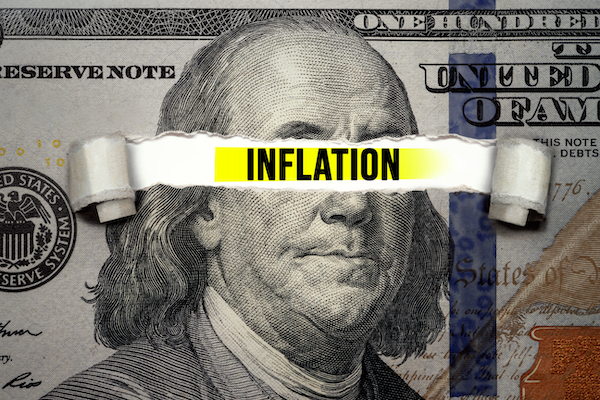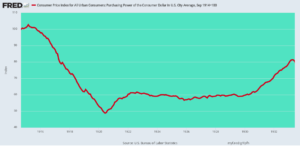
The pre-1971 history proves beyond a shadow of doubt that you don’t need a fixed rate of inflation to enable economic growth, as today’s central bankers and their Wall Street acolytes endlessly insist. And it also reminds us that there is not some innate tendency for the currency to relentlessly depreciate.
Today’s 2% inflation mantra was constructed from the erroneous research by Milton Friedman and his disciple, Ben Bernanke, based on the period before WWII. They studied the Depression years after 1929 and basically concluded that we need inflation to avoid any possible similar deflation period. But they failed to look at the crucial 15-year period preceding the Great Depression.
What happened was this.
In November 1914, the Fed opened for business and was then promptly drafted to finance America’s ill-fated entry into World War I (WWI).
The effect of massive money printing to finance the war was a 51% depreciation of the dollar’s purchasing power by the crest of the post-WWI inflation in June 1920.
Governments had sold war bonds to both their investor class and average citizens alike, promising that they would be redeemed after the end of hostilities at the pre-war gold parity.
Strange as it sounds to modern ears, governments back in those days took their promises — especially in matters of money — extremely seriously.
The attempt to resume gold convertibility at the pre-war parity (which was the sound thing to do) is what led to the Great Depression. As with any major crisis, this was a difficult period for all the people and would have been totally unnecessary if the government wouldn’t have inflated the dollar in the first place.
What is not said is that the Great Depression would have been a lot less painful and much shorter had it not been for Roosevelt’s New Deal.
As shown by the chart below, the US dollar was well on its way to the restoration of its 1914 value, having recovered 60% of the loss from the June 1920 bottom by the time FDR’s (Franklin D. Roosevelt’s) 100-day New Deal was enacted in June 1933.
Index Of The Dollar’s Purchasing Power From The Fed’s Opening To June 1933

The New Deal put the kibosh on sound money when Roosevelt devalued the dollar by 59% in early 1934, and requiring all holders of gold and gold certificates to surrender them in return for unbacked U.S. Treasury bonds.
But by then, the natural part of the depression—the purge of WWI and Roaring Twenties excesses—was already over.
Yet, what the fiat money twins — Friedman and Bernanke — did was to blame the restoration of the dollar’s value in the early 1930s for the Great Depression. They referred to this positive development by the negative term “deflation” and held that it resulted from the fact that the money supply (M1 or currency and deposits) in the banking system contracted sharply during the four years after the October 1929 crash.
The so-called “deflation” was really nothing more than a belated and old-fashioned attempt to purge the economy of war inflation, a process that the world at that time well understood.
The 1929–1933 did not prove that capitalism has some kind of deflationary death wish nor that gold-backed money inherently causes economic contraction.
Market capitalism does not slip into an irreversible deflationary spiral on its own.
And we certainly don’t need central bankers to target a 2.00% or better rise in the general price level so that inflation doesn’t run too close to the 0.0% edge and risk slipping into the abyss. There is no abyss — that’s just a convenient fiction of Keynesian central bankers.
Editor’s Note: The 2020s will likely to be an increasingly volatile time. More governments are putting their money printing on overdrive. Negative interests are becoming the rule instead of the exception to it.
One thing is for sure, there will be a great deal of change taking place in the years ahead.
That’s precisely why legendary speculator Doug Casey and his team released an urgent new report titled
Doug Casey’s Top 7 Predictions for the Raging 2020s.